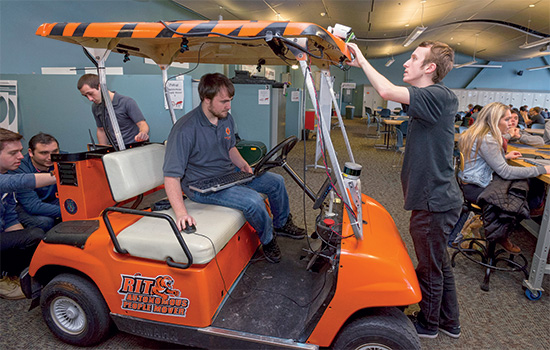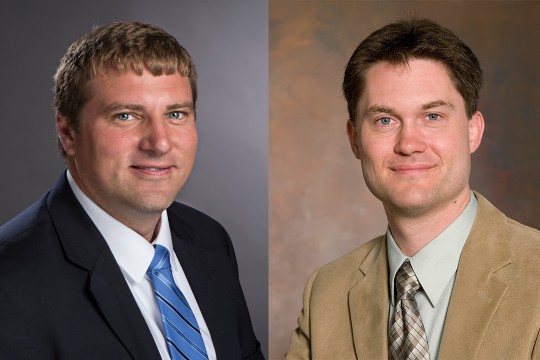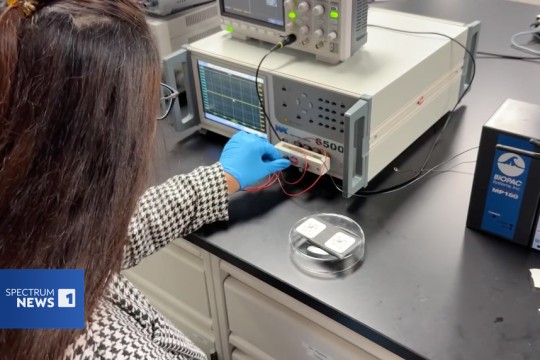Students solve problems in senior design program
Moving People: Computer engineering student Jeff Barker, standing, checks the placement of a wide-angle camera while computer engineering student Greg Mullin, seated, tests the sensor technology on the Autonomous People Mover. Left to right, teammates Robert Relyea, computer engineering, Anthony Luciano and Noah LoConte, both electrical engineering, check vehicle wiring during an onsite test.
Multidisciplinary senior design projects are the practicum for modern design thinking.
Human Solutions
Putting their autonomous vehicle prototype through its paces on the engineering quad, student team members monitor sensor responses as the full-sized golf cart skims quietly across the walkway. Under the hood, their artificial intelligence technology “taught” the Autonomous People Mover to recognize and avoid curbs, statues, and classmates walking to and from campus buildings.
Just a few years ago, full-system autonomy was limited, said Raymond Ptucha, associate professor of computer engineering and team faculty adviser.
“Technology is advancing at an exponential pace. It is awesome to watch it evolve in front of us,” he said. “Due to the popularity and proliferation of driver assistance and autonomous driving, the platforms these students are working on today will be commonplace in a few years. They will look back and say they were one of the first pioneers working on making autonomous vehicles a reality.”
The Autonomous People Mover is one of 80-plus projects in the multidisciplinary senior design (MSD) program. A two-course sequence for students in RIT’s Kate Gleason College of Engineering, MSD gives them a start-to-finish design-and-build experience similar to what they can expect in industry.
Grounded in a structured engineering design process, it begins with detailing customer requirements and ends with delivery of a product or process tested against those requirements. RIT’s students are learning to develop real, human solutions using modern technologies.
Defining and Researching
What do customers need? How will they use a product? Can technology be integrated to improve a design or a process? These are some of the questions being addressed through the program, said Beth DeBartolo, director of the multidisciplinary senior design program and associate professor of mechanical engineering.
“It may be one of the few times students will see an entire project all the way through, from defining the problem for the customer to delivering a prototype,” she said.
She works with faculty and guides—mostly retired engineers from local corporations—to assess projects and determine appropriate scope. Projects align with tracks in specialty areas of the engineering college such as biomedical systems and technologies, vehicle systems, autonomous systems and controls, energy and sustainable systems, printing, and imaging.
Projects are further categorized by process improvements, corporate product improvements and skill acquisition, social impact, or possible commercialization.
Preparation begins with instruction about logistics and elements of the design process including how to write customer requirements and conduct interviews. Working on site in a large design space in the engineering college, guides mentor students through the process where they are judged on project outcomes, adherence to the design process, and their ability to function effectively on teams.
There is no “normal” for projects, DeBartolo added. Team makeup is always different and approaches taken vary with students’ experiences from early co-ops and ideas. All projects, however, are based on design research philosophies and situational guidance emphasizing the importance of real- world solutions.
Students must approach solutions logically and strategically. That is where the design process comes in—it is a model to solve complex problems by breaking them into small, manageable pieces.
Prototyping and Testing
“The scope was huge,” said Jeff Barker, a fifth-year computer engineering major from Valatie, N.Y., who helps lead the Autonomous People Mover (APM) project, now in its fifth iteration.
The goal is to have the autonomous golf cart respond to an individual’s text message requesting a ride to specified campus locations, he explained. In previous designs, the APM moved to and from several programmed destinations. This year’s team decided that full autonomy meant the cart had to be able to detect, in real time, curbs and other obstacles to get to designated locations.
“Prior MSD teams have not used machine learning; this year’s team is the first to do so,” said Ptucha, whose background is in computer vision, robotics, and embedded control systems. “They are using deep learning to determine how to steer the APM. Data from a wide-angle, front-mounted camera is passed into a deep-learning algorithm that labels each pixel as road or non-road, good or bad. It helps the golf cart stay on the path, regardless if it is driving on brick, cement, or blacktop.”
The 16-channel LiDAR—light detection and ranging equipment—was moved from the top of the vehicle and mounted on the front of the chassis for better range. Additional sensors were added to side panels.
With the wide-angle camera, sensors, and deep neural network techniques, important data is produced about terrain and objects that gives the team the ability to refine the vehicle’s trajectory in real time. LiDAR, vision sensors, and image recognition are at the root of how autonomous vehicles function. The refitted design the students implemented is part of that trend.
At the most recent Consumer Electronics Show, top car companies demonstrated their latest autonomous vehicles, many using similar sensing technologies.
“We are trying to show that we have a system confident enough to avoid obstacles while still ‘smartly’ determining where it should go,” said Barker, part of the team of computer, electrical, and industrial engineering students working on the project with Ptucha and guide Ken Mihalyov. Mihalyov is an adjunct engineering faculty member and former chief innovation officer for Xerox Corp.’s public sector services business and its Palo Alto Research Center.
Some projects are sponsored by university faculty to further research goals, including the creation of a tool or capability not currently available, demonstrating that RIT students have the skills to support larger or more wide-ranging grant opportunities, said Mihalyov.
“This second outcome is one of the primary goals that Dr. Ptucha has outlined for the Automated People Mover project. He enables both the challenge and the opportunity for student teams to build on previous work and demonstrate competence in emerging technical fields,” he explained. “The addition of computer vision approaches for cart path identification is one example of a technical field being added for this project.”
In the past few years, MSD teams began including peers from RIT’s business and imaging arts colleges, particularly those from the industrial design program, and their input has made an impact.
“Their design process is similar,” said DeBartolo. “The way they address each of the steps may be different, the words they may use to describe those steps may be different, but when it comes right down to it, what they are doing is identifying a problem, coming up with solutions, picking the best one, and then implementing it or building it.
“Once you figure out where the similarities are and where the processes overlap and figure out how to translate the information, it turns out we are all doing the same thing. What I call low fidelity mock-up, they may call initial product testing. We just have a different name for it, but we don’t view results that differently.”
DeBartolo requires project teams to write “use cases”—details of how customers intend to use the product or process.
“What does that interaction look like, and once they understand the different scenarios, they can understand performance boundaries and start to develop requirements,” she said.
This information is required for identifying potential solutions and determining how the final engineered solution will be tested to verify that it meets requirements.
Making a Difference
Testing is a significant part of the design process, and the MSD program is also a means for established groups like the university’s performance racing teams to assess different technology and equipment before it is integrated into vehicles when competition seasons open.
For example, the Baja Off Road team sponsored a project to build a hybrid drive train for the car, and the Formula SAE team explored active aerodynamics.
In addition to new or improved products, some teams have seen products evolve toward possible commercialization. Other teams build new products or systems that are specific to a company, and students are acquiring specific industry skills. Other project ideas include inter–national connections.
“It is work that makes a difference,” DeBartolo said. “Look at the field of sanitation in developing nations, for example. Students are doing work that can literally save lives. Projects include everything from developing the prototype to coming up with a manufacturing process that is viable onsite with materials and skills available in the country. That is a very different set of design challenges. The products are not complex, but it takes some creativity to find a feasible solution.”
Projects are often done on limited budgets. Some teams seek grant funding, and this past fall three groups received financial support from national organizations such as NASA and ASTM.
Projects are also part of larger faculty grants from the National Science Foundation, National Institutes of Health, and Department of Defense. Student-engineers also participate on projects with other college faculty.
For example, working with faculty in RIT’s College of Science, students helped improve imaging technologies for archaeological monitoring and built lift equipment for the high-tech cameras used to take photos of oversized artwork at the Museum of Modern Art in New York City. They are creative projects driven by the need for realistic solutions.
“Some people have a romanticized idea of what an autonomous vehicle is and what it can do,” said Robert Relyea, a fifth-year computer engineering student from Doylestown, Pa., and lead engineer on the APM project. “The ideal solution is a seamless system that can drive like a human can drive. But underneath that layer of abstraction, there are all these systems we are working on. We have to collect more data for different scenarios and would need thousands of images to have a fully reliable data set on conditions for image detection and classification.”
Relyea and the team resumed work on the APM during spring semester. Drives around campus were more than joy rides, but data-gathering opportunities. Their project is as much about integrating autonomous technologies as it is about exploring complexity and finding alternative ways to solve problems.













